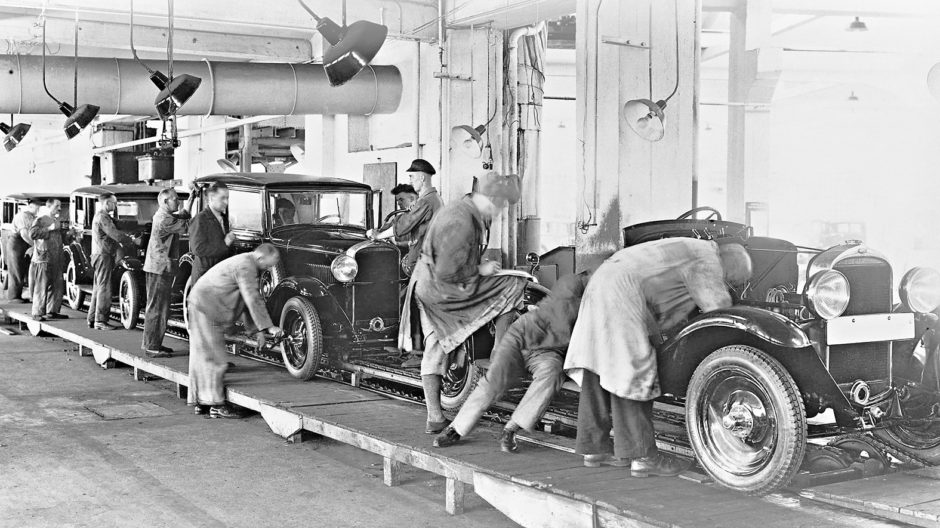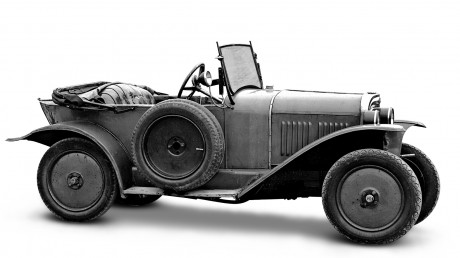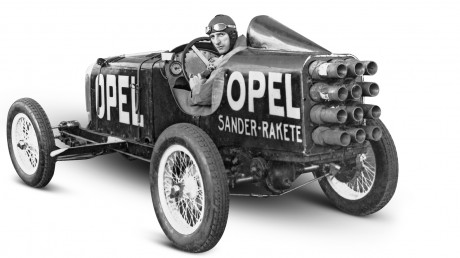- Im Jahr 1924 begann die Fließband-Produktion. Das Foto zeigt Arbeiter im Jahr 1931.
- Der Admiral führte 1937 das Konzept der selbsttragenden Sicherheitskarosserie in die Luxusklasse ein.
- Den Motorradmarkt revolutionierte Opel mit der „Motoclub“
The times experienced by Opel in the early 20th century were full of progress. By 1923 the company had grown to become the largest manufacturer of bicycles in the world. Racing cars from Rüsselsheim were winning races and setting records, and Opel revolutionized the motorcycle market with its avant-garde Motoclub model. 1924 saw the first assembly line in Germany, with capacity for up to 100 cars to be built each day. The compact 4/12 PS was the top-seller: known as the ‘Tree Frog’ because of its green paintwork, the nippy little machine appealed to the masses with its simple technology and affordable price. One in three were destined for the export market.
A Brand Flying High
When GM assumed a majority stake in 1929, the brand was set to fly high. With technical support from the U.S., the model range was extensively modernized. 1930 saw the launch of the first generation of Blitz trucks. A competition was held among employees to come up with the name, which was duly found. Opel rewrote technical history in 1935 with the Olympia 1.3 liter. The first German mass-produced vehicle with a self-supporting full steel chassis, a design principle still valid today, left the assembly line in Rüsselsheim. Patented by Opel, this manufacturing technology was also groundbreaking. The chassis was connected to the pre-assembled drive system and the axles during the manufacturing process. This efficient process could accommodate large volumes. The company was the first German manufacturer to exceed the 100,000 mark in 1935. By 1936 Opel had gone on to become the largest carmaker in Europe, selling 120,852 cars and trucks. Veritable bestsellers followed in the second half of the 1930s. In 1936, the Opel Kadett brought the concept of the self-supporting safety chassis to lower-end models. The stately Admiral introduced the concept to the high-end market in 1937. The Opel Kapitän, which was also manufactured with a full steel chassis and equipped with a modern six-cylinder engine, was launched in 1939, with its popularity reaching a peak after the war. The assembly lines came to a halt in 1940. The carefree and eventful times were at an end for the time being.
Part 1: Through the Thread of Time
Part 2: Success from unpromising beginnings
Part 3: The 8 HP Breakthrough
Fritz von Opel was one of the pioneers of the rocket age and made his mark on the world of technology. After his spectacular record-breaking run in the rocket car RAK 2 at Berlin’s AVUS racetrack in May 1928, Fritz von Opel became the first person to overcome gravity in a rocket-powered aircraft at the Frankfurt airfield on September 30, 1929. After flying for one and a half minutes and traveling two kilometers, von Opel landed by the side of the road. The first flight with a rocket-propelled aircraft had been a success. Mankind had come a step closer to space. The newspaper headlines the next day read ‘First human rocket.’ The Sander-Rakete was a prototype.






